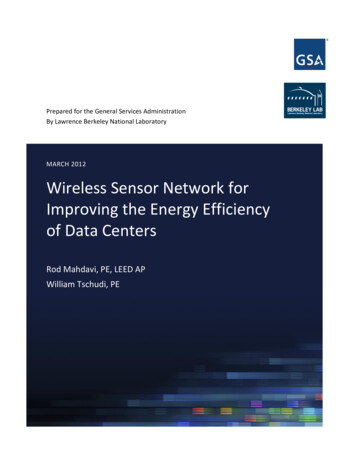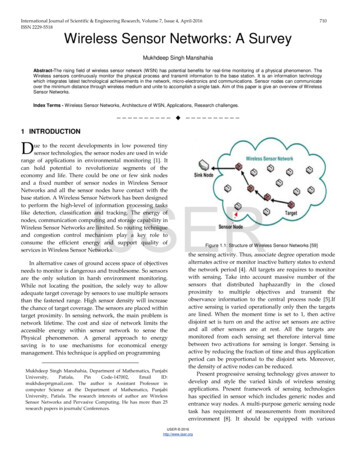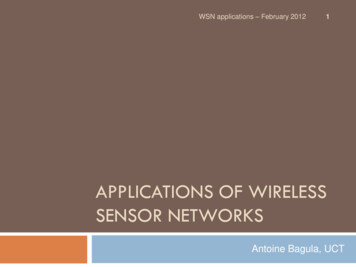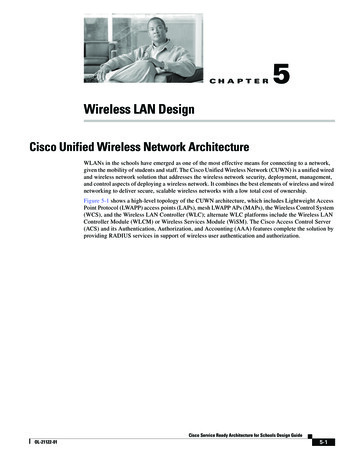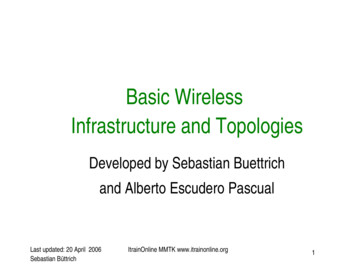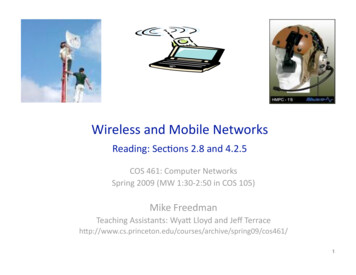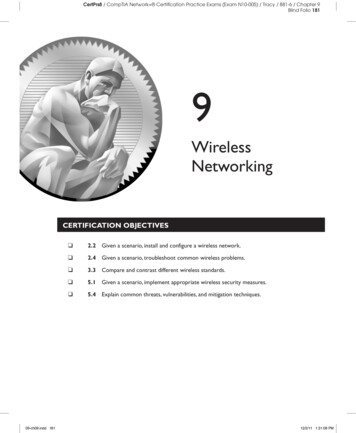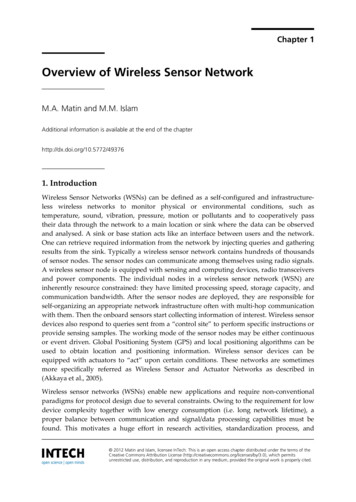
Transcription
Chapter 1Overview of Wireless Sensor NetworkM.A. Matin and M.M. IslamAdditional information is available at the end of the chapterhttp://dx.doi.org/10.5772/493761. IntroductionWireless Sensor Networks (WSNs) can be defined as a self-configured and infrastructureless wireless networks to monitor physical or environmental conditions, such astemperature, sound, vibration, pressure, motion or pollutants and to cooperatively passtheir data through the network to a main location or sink where the data can be observedand analysed. A sink or base station acts like an interface between users and the network.One can retrieve required information from the network by injecting queries and gatheringresults from the sink. Typically a wireless sensor network contains hundreds of thousandsof sensor nodes. The sensor nodes can communicate among themselves using radio signals.A wireless sensor node is equipped with sensing and computing devices, radio transceiversand power components. The individual nodes in a wireless sensor network (WSN) areinherently resource constrained: they have limited processing speed, storage capacity, andcommunication bandwidth. After the sensor nodes are deployed, they are responsible forself-organizing an appropriate network infrastructure often with multi-hop communicationwith them. Then the onboard sensors start collecting information of interest. Wireless sensordevices also respond to queries sent from a “control site” to perform specific instructions orprovide sensing samples. The working mode of the sensor nodes may be either continuousor event driven. Global Positioning System (GPS) and local positioning algorithms can beused to obtain location and positioning information. Wireless sensor devices can beequipped with actuators to “act” upon certain conditions. These networks are sometimesmore specifically referred as Wireless Sensor and Actuator Networks as described in(Akkaya et al., 2005).Wireless sensor networks (WSNs) enable new applications and require non-conventionalparadigms for protocol design due to several constraints. Owing to the requirement for lowdevice complexity together with low energy consumption (i.e. long network lifetime), aproper balance between communication and signal/data processing capabilities must befound. This motivates a huge effort in research activities, standardization process, and 2012 Matin and Islam, licensee InTech. This is an open access chapter distributed under the terms of theCreative Commons Attribution License (http://creativecommons.org/licenses/by/3.0), which permitsunrestricted use, distribution, and reproduction in any medium, provided the original work is properly cited.
4 Wireless Sensor Networks – Technology and Protocolsindustrial investments on this field since the last decade (Chiara et. al. 2009). At presenttime, most of the research on WSNs has concentrated on the design of energy- andcomputationally efficient algorithms and protocols, and the application domain has beenrestricted to simple data-oriented monitoring and reporting applications (Labrador et. al.2009). The authors in (Chen et al., 2011) propose a Cable Mode Transition (CMT) algorithm,which determines the minimal number of active sensors to maintain K-coverage of a terrainas well as K-connectivity of the network. Specifically, it allocates periods of inactivity forcable sensors without affecting the coverage and connectivity requirements of the networkbased only on local information. In (Cheng et al., 2011), a delay-aware data collectionnetwork structure for wireless sensor networks is proposed. The objective of the proposednetwork structure is to minimize delays in the data collection processes of wireless sensornetworks which extends the lifetime of the network. In (Matin et al., 2011), the authors haveconsidered relay nodes to mitigate the network geometric deficiencies and used ParticleSwarm Optimization (PSO) based algorithms to locate the optimal sink location with respectto those relay nodes to overcome the lifetime challenge. Energy efficient communication hasalso been addressed in (Paul et al., 2011; Fabbri et al. 2009). In (Paul et al., 2011), the authorsproposed a geometrical solution for locating the optimum sink placement for maximizingthe network lifetime. Most of the time, the research on wireless sensor networks haveconsidered homogeneous sensor nodes. But nowadays researchers have focused onheterogeneous sensor networks where the sensor nodes are unlike to each other in terms oftheir energy. In (Han et al., 2010), the authors addresses the problem of deploying relaynodes to provide fault tolerance with higher network connectivity in heterogeneous wirelesssensor networks, where sensor nodes possess different transmission radii. New networkarchitectures with heterogeneous devices and the recent advancement in this technologyeliminate the current limitations and expand the spectrum of possible applications for WSNsconsiderably and all these are changing very rapidly.Figure 1. A typical Wireless Sensor Network2. Applications of wireless sensor networkWireless sensor networks have gained considerable popularity due to their flexibility insolving problems in different application domains and have the potential to change our lives
Overview of Wireless Sensor Network 5in many different ways. WSNs have been successfully applied in various applicationdomains (Akyildiz et al. 2002; Bharathidasan et al., 2001), (Yick et al., 2008; Boukerche, 2009),(Sohraby et al., 2007), and ( Chiara et al., 2009;Verdone et al., 2008), such as:Military applications: Wireless sensor networks be likely an integral part of militarycommand, control, communications, computing, intelligence, battlefield surveillance,reconnaissance and targeting systems.Area monitoring: In area monitoring, the sensor nodes are deployed over a region wheresome phenomenon is to be monitored. When the sensors detect the event being monitored(heat, pressure etc), the event is reported to one of the base stations, which then takesappropriate action.Transportation: Real-time traffic information is being collected by WSNs to later feedtransportation models and alert drivers of congestion and traffic problems.Health applications: Some of the health applications for sensor networks are supportinginterfaces for the disabled, integrated patient monitoring, diagnostics, and drugadministration in hospitals, tele-monitoring of human physiological data, and tracking &monitoring doctors or patients inside a hospital.Environmental sensing: The term Environmental Sensor Networks has developed to covermany applications of WSNs to earth science research. This includes sensing volcanoes,oceans, glaciers, forests etc. Some other major areas are listed below: Air pollution monitoringForest fires detectionGreenhouse monitoringLandslide detectionStructural monitoring: Wireless sensors can be utilized to monitor the movement withinbuildings and infrastructure such as bridges, flyovers, embankments, tunnels etc enablingEngineering practices to monitor assets remotely with out the need for costly site visits.Industrial monitoring: Wireless sensor networks have been developed for machinerycondition-based maintenance (CBM) as they offer significant cost savings and enable newfunctionalities. In wired systems, the installation of enough sensors is often limited by thecost of wiring.Agricultural sector: using a wireless network frees the farmer from the maintenance ofwiring in a difficult environment. Irrigation automation enables more efficient water useand reduces waste.3. Design issues of a wireless sensor networkThere are a lot of challenges placed by the deployment of sensor networks which are asuperset of those found in wireless ad hoc networks. Sensor nodes communicate overwireless, lossy lines with no infrastructure. An additional challenge is related to the limited,
6 Wireless Sensor Networks – Technology and Protocolsusually non-renewable energy supply of the sensor nodes. In order to maximize the lifetimeof the network, the protocols need to be designed from the beginning with the objective ofefficient management of the energy resources (Akyildiz et al., 2002). Wireless SensorNetwork Design issues are mentioned in (Akkaya et al., 2005), (Akyildizet al., 2002),(SensorSim; Tossim, Younis et al., 2004), (Pan et al., 2003) and different possible platformsfor simulation and testing of routing protocols for WSNs are discussed in ( NS-2, Zeng et al.,1998, SensorSim, Tossiim ). Let us now discuss the individual design issues in greater detail.Fault Tolerance: Sensor nodes are vulnerable and frequently deployed in dangerousenvironment. Nodes can fail due to hardware problems or physical damage or byexhausting their energy supply. We expect the node failures to be much higher than the onenormally considered in wired or infrastructure-based wireless networks. The protocolsdeployed in a sensor network should be able to detect these failures as soon as possible andbe robust enough to handle a relatively large number of failures while maintaining theoverall functionality of the network. This is especially relevant to the routing protocoldesign, which has to ensure that alternate paths are available for rerouting of the packets.Different deployment environments pose different fault tolerance requirements.Scalability: Sensor networks vary in scale from several nodes to potentially several hundredthousand. In addition, the deployment density is also variable. For collecting highresolution data, the node density might reach the level where a node has several thousandneighbours in their transmission range. The protocols deployed in sensor networks need tobe scalable to these levels and be able to maintain adequate performance.Production Costs: Because many deployment models consider the sensor nodes to bedisposable devices, sensor networks can compete with traditional information gatheringapproaches only if the individual sensor nodes can be produced very cheaply. The targetprice envisioned for a sensor node should ideally be less than 1.Hardware Constraints: At minimum, every sensor node needs to have a sensing unit, aprocessing unit, a transmission unit, and a power supply. Optionally, the nodes may haveseveral built-in sensors or additional devices such as a localization system to enablelocation-aware routing. However, every additional functionality comes with additional costand increases the power consumption and physical size of the node. Thus, additionalfunctionality needs to be always balanced against cost and low-power requirements.Sensor Network Topology: Although WSNs have evolved in many aspects, they continue tobe networks with constrained resources in terms of energy, computing power, memory, andcommunications capabilities. Of these constraints, energy consumption is of paramountimportance, which is demonstrated by the large number of algorithms, techniques, andprotocols that have been developed to save energy, and thereby extend the lifetime of thenetwork. Topology Maintenance is one of the most important issues researched to reduceenergy consumption in wireless sensor networks.Transmission Media: The communication between the nodes is normally implementedusing radio communication over the popular ISM bands. However, some sensor networks
Overview of Wireless Sensor Network 7use optical or infrared communication, with the latter having the advantage of being robustand virtually interference free.Power Consumption: As we have already seen, many of the challenges of sensor networksrevolve around the limited power resources. The size of the nodes limits the size of thebattery. The software and hardware design needs to carefully consider the issues of efficientenergy use. For instance, data compression might reduce the amount of energy used forradio transmission, but uses additional energy for computation and/or filtering. The energypolicy also depends on the application; in some applications, it might be acceptable to turnoff a subset of nodes in order to conserve energy while other applications require all nodesoperating simultaneously.4. Structure of a wireless sensor networkStructure of a Wireless Sensor Network includes different topologies for radiocommunications networks. A short discussion of the network topologies that apply towireless sensor networks are outlined below:4.1. Star network (single point-to-multipoint) (Wilson, 2005)A star network is a communications topology where a single base station can send and/orreceive a message to a number of remote nodes. The remote nodes are not permitted to sendmessages to each other. The advantage of this type of network for wireless sensor networksincludes simplicity, ability to keep the remote node’s power consumption to a minimum. Italso allows low latency communications between the remote node and the base station. Thedisadvantage of such a network is that the base station must be within radio transmissionrange of all the individual nodes and is not as robust as other networks due to itsdependency on a single node to manage the network.Figure 2. A Star network topology
8 Wireless Sensor Networks – Technology and Protocols4.2. Mesh network (Wilson, 2005)A mesh network allows transmitting data to one node to other node in the network that iswithin its radio transmission range. This allows for what is known as multi-hopcommunications, that is, if a node wants to send a message to another node that is out ofradio communications range, it can use an intermediate node to forward the message to thedesired node. This network topology has the advantage of redundancy and scalability. If anindividual node fails, a remote node still can communicate to any other node in its range,which in turn, can forward the message to the desired location. In addition, the range of thenetwork is not necessarily limited by the range in between single nodes; it can simply beextended by adding more nodes to the system. The disadvantage of this type of network isin power consumption for the nodes that implement the multi-hop communications aregenerally higher than for the nodes that don’t have this capability, often limiting the batterylife. Additionally, as the number of communication hops to a destination increases, the timeto deliver the message also increases, especially if low power operation of the nodes is arequirement.Figure 3. A Mesh network topology4.3. Hybrid star – Mesh network (Wilson, 2005)A hybrid between the star and mesh network provides a robust and versatilecommunications network, while maintaining the ability to keep the wireless sensor nodespower consumption to a minimum. In this network topology, the sensor nodes with lowestpower are not enabled with the ability to forward messages. This allows for minimal powerconsumption to be maintained. However, other nodes on the network are enabled withmulti-hop capability, allowing them to forward messages from the low power nodes toother nodes on the network. Generally, the nodes with the multi-hop capability are higherpower, and if possible, are often plugged into the electrical mains line. This is the topologyimplemented by the up and coming mesh networking standard known as ZigBee.
Overview of Wireless Sensor Network 9Figure 4. A Hybrid Star – Mesh network topology5. Structure of a wireless sensor nodeA sensor node is made up of four basic components such as sensing unit, processing unit,transceiver unit and a power unit which is shown in Fig. 5. It also has application dependentadditional components such as a location finding system, a power generator and amobilizer. Sensing units are usually composed of two subunits: sensors and analogue todigital converters (ADCs) (Akyildiz et al., 2002). The analogue signals produced by thesensors are converted to digital signals by the ADC, and then fed into the processing unit.The processing unit is generally associated with a small storage unit and it can managethe procedures that make the sensor node collaborate with the other nodes to carry outthe assigned sensing tasks. A transceiver unit connects the node to the network. One ofthe most important components of a sensor node is the power unit. Power units can besupported by a power scavenging unit such as solar cells. The other subunits, of the nodeare application dependent.A functional block diagram of a versatile wireless sensing node is provided in Fig. 6.Modular design approach provides a flexible and versatile platform to address the needs ofa wide variety of applications. For example, depending on the sensors to be deployed, thesignal conditioning block can be re-programmed or replaced. This allows for a wide variety
10 Wireless Sensor Networks – Technology and Protocolsof different sensors to be used with the wireless sensing node. Similarly, the radio link maybe swapped out as required for a given applications’ wireless range requirement and theneed for bidirectional communications.Figure 5. The components of a sensor nodeFigure 6. Functional block diagram of a sensor nodeUsing flash memory, the remote nodes acquire data on command from a base station, or byan event sensed by one or more inputs to the node. Moreover, the embedded firmware canbe upgraded through the wireless network in the field.The microprocessor has a number of functions including:
Overview of Wireless Sensor Network 11 Managing data collection from the sensorsperforming power management functionsinterfacing the sensor data to the physical radio layermanaging the radio network protocolA key aspect of any wireless sensing node is to minimize the power consumed by thesystem. Usually, the radio subsystem requires the largest amount of power. Therefore, datais sent over the radio network only when it is required. An algorithm is to be loaded into thenode to determine when to send data based on the sensed event. Furthermore, it isimportant to minimize the power consumed by the sensor itself. Therefore, the hardwareshould be designed to allow the microprocessor to judiciously control power to the radio,sensor, and sensor signal conditioner (Akyildiz et al., 2002).6. Communication structure of a wireless sensor networkThe sensor nodes are usually scattered in a sensor field as shown in Fig. 1. Each of thesescattered sensor nodes has the capabilities to collect data and route data back to the sink andthe end users. Data are routed back to the end user by a multi-hop infrastructure-lessarchitecture through the sink as shown in Fig. 1. The sink may communicate with the taskmanager node via Internet or Satellite.Figure 7. Wireless Sensor Network protocol stackThe protocol stack used by the sink and the sensor nodes is given in Fig. 7. This protocolstack combines power and routing awareness, integrates data with networking protocols,communicates power efficiently through the wireless medium and promotes cooperativeefforts of sensor nodes. The protocol stack consists of the application layer, transport layer,
12 Wireless Sensor Networks – Technology and Protocolsnetwork layer, data link layer, physical layer, power management plane, mobilitymanagement plane, and task management plane (Akyildiz et al., 2002). Different types ofapplication software can be built and used on the application layer depending on thesensing tasks. This layer makes hardware and software of the lowest layer transparent to theend-user. The transport layer helps to maintain the flow of data if the sensor networksapplication requires it. The network layer takes care of routing the data supplied by thetransport layer, specific multi-hop wireless routing protocols between sensor nodes andsink. The data link layer is responsible for multiplexing of data streams, frame detection,Media Access Control (MAC) and error control. Since the environment is noisy and sensornodes can be mobile, the MAC protocol must be power aware and able to minimize collisionwith neighbours’ broadcast. The physical layer addresses the needs of a simple but robustmodulation, frequency selection, data encryption, transmission and receiving techniques.In addition, the power, mobility, and task management planes monitor the power,movement, and task distribution among the sensor nodes. These planes help the sensornodes coordinate the sensing task and lower the overall energy consumption.7. Energy consumption issues in wireless sensor networkEnergy consumption is the most important factor to determine the life of a sensor networkbecause usually sensor nodes are driven by battery. Sometimes energy optimization is morecomplicated in sensor networks because it involved not only reduction of energyconsumption but also prolonging the life of the network as much as possible. Theoptimization can be done by having energy awareness in every aspect of design andoperation. This ensures that energy awareness is also incorporated into groups ofcommunicating sensor nodes and the entire network and not only in the individual nodes(Bharathidasan et al. 2001).A sensor node usually consists of four sub-systems (Bharathidasan et al. 2001): a computing subsystem : It consists of a microprocessor(microcontroller unit, MCU)which is responsible for the control of the sensors and implementation ofcommunication protocols. MCUs usually operate under various modes for powermanagement purposes. As these operating modes involves consumption of power, theenergy consumption levels of the various modes should be considered while looking atthe battery lifetime of each node.a communication subsystem: It consists of a short range radio which communicate withneighboring nodes and the outside world. Radios can operate under the differentmodes. It is important to completely shut down the radio rather than putting it in theIdle mode when it is not transmitting or receiving for saving power.a sensing subsystem : It consists of a group of sensors and actuators and link the nodeto the outside world. Energy consumption can be reduced by using low powercomponents and saving power at the cost of performance which is not required.
Overview of Wireless Sensor Network 13 a power supply subsystem : It consists of a battery which supplies power to the node. Itshould be seen that the amount of power drawn from a battery is checked because ifhigh current is drawn from a battery for a long time, the battery will die faster eventhough it could have gone on for a longer time. Usually the rated current capacity of abattery being used for a sensor node is less than the minimum energy consumption.The lifetime of a battery can be increased by reducing the current drastically or eventurning it off often.To minimize the overall energy consumption of the sensor network, different types ofprotocols and algorithms have been studied so far all over the world. The lifetime of asensor network can be increased significantly if the operating system, the application layerand the network protocols are designed to be energy aware. These protocols and algorithmshave to be aware of the hardware and able to use special features of the micro-processorsand transceivers to minimize the sensor node’s energy consumption. This may push towarda custom solution for different types of sensor node design. Different types of sensor nodesdeployed also lead to different types of sensor networks. This may also lead to the differenttypes of collaborative algorithms in wireless sensor networks arena.8. Protocols & algorithms of wireless sensor networkIn WSN, the main task of a sensor node is to sense data and sends it to the base station inmulti hop environment for which routing path is essential. For computing the routing pathfrom the source node to the base station there is huge numbers of proposed routingprotocols exist (Sharma et al., 2011). The design of routing protocols for WSNs mustconsider the power and resource limitations of the network nodes, the time-varying qualityof the wireless channel, and the possibility for packet loss and delay. To address thesedesign requirements, several routing strategies for WSNs have been proposed in (Labradoret al., 2009), (Akkaya et al., 2005), ( Akyildiz et al. 2002), (Boukerche, 2009, Al-karaki et al.,2004, Pan et al., 2003) and (Waharte et al., 2006).The first class of routing protocols adopts a flat network architecture in which all nodes areconsidered peers. Flat network architecture has several advantages, including minimaloverhead to maintain the infrastructure and the potential for the discovery of multipleroutes between communicating nodes for fault tolerance.A second class of routing protocols imposes a structure on the network to achieve energyefficiency, stability, and scalability. In this class of protocols, network nodes are organized inclusters in which a node with higher residual energy, for example, assumes the role of acluster head. The cluster head is responsible for coordinating activities within the clusterand forwarding information between clusters. Clustering has potential to reduce energyconsumption and extend the lifetime of the network.A third class of routing protocols uses a data-centric approach to disseminate interest withinthe network. The approach uses attribute-based naming, whereby a source node queries anattribute for the phenomenon rather than an individual sensor node. The interest
14 Wireless Sensor Networks – Technology and Protocolsdissemination is achieved by assigning tasks to sensor nodes and expressing queries torelative to specific attributes. Different strategies can be used to communicate interests to thesensor nodes, including broadcasting, attribute-based multicasting, geo-casting, and anycasting.A fourth class of routing protocols uses location to address a sensor node. Location-basedrouting is useful in applications where the position of the node within the geographicalcoverage of the network is relevant to the query issued by the source node. Such a querymay specify a specific area where a phenomenon of interest may occur or the vicinity to aspecific point in the network environment.In the rest of this section we discuss some of the major routing protocols and algorithms todeal with the energy conservation issue in the literatures.1.Flooding: Flooding is a common technique frequently used for path discovery andinformation dissemination in wired and wireless ad hoc networks which has beendiscussed in (Akyildiz et al., 2002). The routing strategy of flooding is simple and doesnot rely on costly network topology maintenance and complex route discoveryalgorithms. Flooding uses a reactive approach whereby each node receiving a data orcontrol packet sends the packet to all its neighbors. After transmission, a packet followsall possible paths. Unless the network is disconnected, the packet will eventually reachits destination. Furthermore, as the network topology changes, the packet transmittedfollows the new routes. Fig. 8 illustrates the concept of flooding in data communicationsnetwork. As shown in the figure, flooding in its simplest form may cause packets to bereplicated indefinitely by network nodes.Figure 8. Flooding in data communication networks
Overview of Wireless Sensor Network 151.Gossiping:To address the shortcomings of flooding, a derivative approach, referred to as gossiping, hasbeen proposed in ( Braginsky et al., 2002). Similar to flooding, gossiping uses a simpleforwarding rule and does not require costly topology maintenance or complex routediscovery algorithms. Contrary to flooding, where a data packet is broadcast to allneighbors, gossiping requires that each node sends the incoming packet to a randomlyselected neighbor. Upon receiving the packet, the neighbor selected randomly chooses oneof its own neighbors and forwards the packet to the neighbor chosen. This process continuesiteratively until the packet reaches its intended destination or the maximum hop count isexceeded.2.Protocols for Information via Negotiation (SPIN):Sensor protocols for information via negotiation (SPIN), is a data-centric negotiation-basedfamily of information dissemination protocols for WSNs (Kulik et al., 2002). The mainobjective of these protocols is to efficiently disseminate observations gathered by individualsensor nodes to all the sensor nodes in the network. Simple protocols such as flooding andgossiping are commonly proposed to achieve information dissemination in WSNs. Floodingrequires that each node sends a copy of the data packet to all its neighbors until theinformation reaches all nodes in the network. Gossiping, on the other hand, usesrandomization to reduce the number of duplicate packets and requires only that a nodereceiving a data packet forward it to a randomly selected neighbor.Figure 9. SPIN basic protocol operation
16 Wireless Sensor Networks – Technology and Protocols3.Low-Energy Adaptive Clustering Hierarchy (LEACH)Low-energy adaptive clustering hierarchy (LEACH) is a routing algorithm designed tocollect and deliver data to the data sink, typically a base station (Heinzelman et. al. 2000).The main objectives of LEACH are: Extension of the network lifetimeReduced energy consumption by each network sensor nodeUse of data aggregation to reduce the number of communication messagesTo achieve these objectives, LEACH adopts a hierarchical approach to organize the networkinto a set of clusters. Each cluster is managed by a selected cluster head. The cluster headassumes the responsibility to carry out multiple tasks. The first task consists of periodiccollection of data from the members of the cluster. Upon gathering the data, the cluster headaggregates it in an effort to remove redundancy among correlated values. The second maintask of a cluster head is to transmit the aggregated data directly to the base station oversingle hop. The third main task of the cluster head is to create a TDMA-based schedulewhereby each node of the cluster is assigned a time slot that it can use for tran
Wireless sensor devices can be equipped with actuators to “act” upon certain conditions. These networks are sometimes more specifically referred as Wireless Sensor and Actuator Networks as described in (Akkaya et al., 2005). Wireless sensor networks (W

